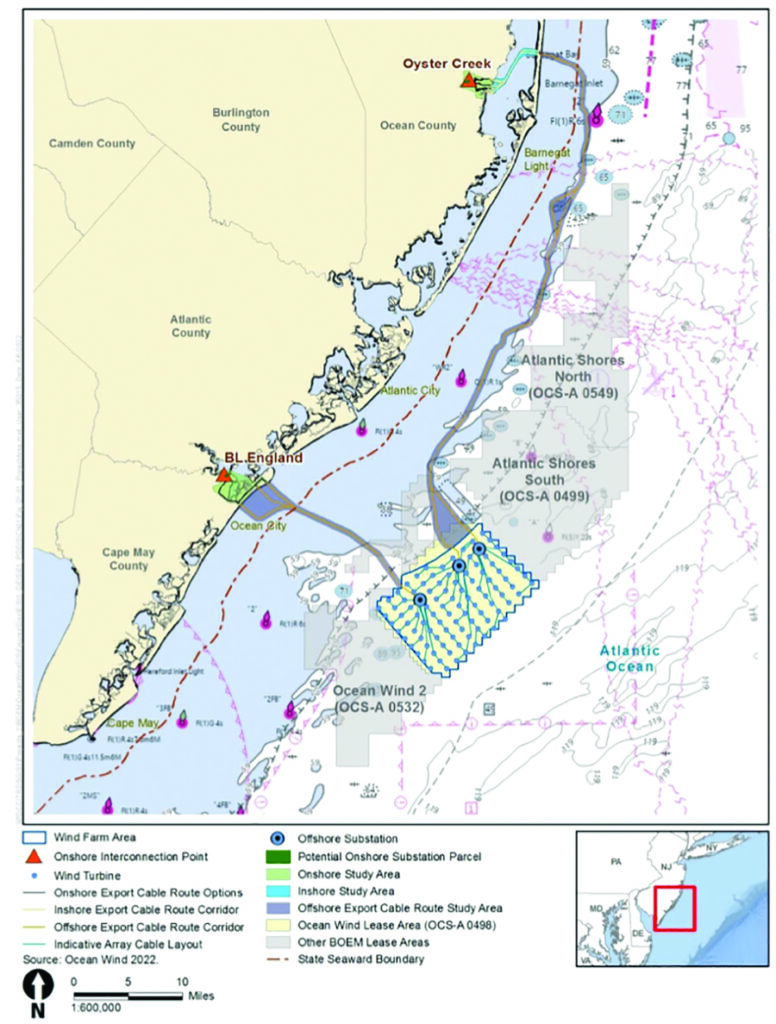
OCEAN CITY – The federal Bureau of Ocean Energy Management is downplaying potential adverse effects of offshore wind projects by setting faulty baselines in its Draft Environmental Impact Statement (DEIS) on Ocean Wind 1.
That’s the argument by Barbara McCall, a Florida resident who owns property in Ocean City. She argues having more accurate baselines on the potential impact of wind farms on commercial fishing and tourism, among other areas, would give New Jersey residents better information so they could make up their minds about this renewable energy source.
It isn’t as if BOEM hasn’t put forward a lot of information. The DEIS is a 1,400-page document about the proposal to install 98 wind turbines on a plot 15 miles off the coast of Cape May and Atlantic counties. The problem for many is analyzing the voluminous draft. After complaints from numerous individuals and environmental groups that they didn’t have enough time, BOEM extended its 45-day comment period by another 15 days to allow greater response. That additional period ended Aug. 23.
McCall sent in a 3,500-word response, with footnotes, to BOEM, which is part of the Department of the Interior, during the comment period. (The entire response is online at ocnjsentinel.com.)
The Winter Garden resident said while she rents out her Ocean City residence, she also vacations here and has been coming to the resort since she was born. “I have family in Texas and we all still meet in Ocean City,” she said. “That’s how much we love it.”
McCall acknowledged that she does not know what is on all of the 1,400 pages in the document, “but I tried to do my best to do a cursory look at the whole document and then I devoted some time into specific resource areas. The conclusions they were coming up with seemed to be untenable to me. I really delved into them specifically.”
She cited a range of topics included in the report where she believes BOEM is under-representing potential adverse effects from the wind farm.
She said the politicians and companies behind the projects, including Danish company Ørsted and PSEG, which are teaming up to build Ocean Wind 1, “should not be afraid of being truthful and transparent.”
Specks on the horizon?
McCall said she has heard the “ambiguous statement” that the majority of people in New Jersey support offshore wind projects, but she doesn’t believe most people know what all the projects entail.
“They should know the contents of these wind turbines, how many wind turbines are in the proposal and should know the distance from the coastline. I also think they should know exactly where these cable lines should be coming through,” including the substations.
One set of transmission lines is planned to connect to the power grid at the former Oyster Creek nuclear plant in Ocean County and the other set is slated to run through Ocean City and out to Upper Township to connect to the grid at the former B.L. England generating plant in Beesleys Point.
“There will be wind turbines out there, they will look like specks on the horizon and will be 15 miles off shore,” McCall said how Gov. Phil Murphy, a wind energy proponent, phrased it recently. “That’s not a true perception of what is going on,” she said.
McCall also pointed out the potential environmental risks of the turbines because of their content. Each contains some 1,585 gallons of transformer oil and 146 gallons of general oil (for gearboxes and hydraulics) and other chemicals including diesel fuel and sulfur hexafluoride, which the Environmental Protection Agency lists as the most potent greenhouse gas. The most danger is posed from construction, maintenance and decommissioning, according to the EPA.
Having a greenhouse gas goes in direct contravention of the purpose of the wind turbines, which is to reduce the emissions of greenhouse gases generated by plants that use fossil fuels, she said. “It’s a concern.”
Traffic to and from
“They’re telling us on one hand there’s going to be 1,539 vessel trips during construction and installation, 3,395 vessel trips per year during operation and maintenance, and approximately the same during decommissioning as during construction and installation,” McCall said. In addition there are some 2,500 helicopter trips going out to these locations.
“I found it difficult to believe adding that many vessels into this area would not have a major impact on vessel navigation,” she said. “It didn’t seem believable.”
That’s when she looked into the impact of the transmission cables.
She said there will be 175 miles of offshore underground transmission cables, a 50-foot wide construction corridor onshore for cable and a 30-foot permanent easement beyond the construction corridor.
“The corridor for the cable will run 30 blocks through the heart of the island of Ocean City,” she wrote to BOEM. “Offshore cable will be installed along 60 percent of Ocean City’s beachfront. According to the cable route, land designated as Green Acres will be confiscated at a state park on the island.”
McCall said BOEM is misrepresenting the facts to lower the potential impact of the Ocean Wind project by integrating other proposed offshore wind farms into its analysis. That is a theme she sees throughout the BOEM report.
“The noted frequency of this strategy runs counter to society’s accepted moral code of values and has the impact of undermining public trust,” she wrote.
Fishing, tourism
McCall cites a report from the National Oceanic and Atmospheric Administration (NOAA) that the amount of revenue from New Jersey commercial fishing has increased each year from 2017 through 2021 with total earnings ranging from $169,701,007 to $258,657,952. The commercial fishing industry in Cape May County is one of the largest employers and revenue producers in the county and one of the largest on the East Coast.
What concerns her about the impact statement is that BOEM concludes the fishing industry will improve in the face of the 98 wind turbines off the coast in Ocean Wind 1 and another 1,337 turbines after that in the other projects.
“I think BOEM needs to provide tangible evidence to state why Ocean Wind project and other projects to follow will actually improve New Jersey’s commercial fishing industry. Technically that’s what they’re asserting.”
She notes wording in the DEIS references “minor to major” impact on commercial fishing “depending on the fisheries.” That language, she said, compromises the report tables indicating a lesser impact. “We want to know what commercial industries will be impacted by this because you can assume that some will be impacted,” she said. “What are the details? What are the specifics?” It’s not clear if the impact refers to geographic locations or types of fisheries.
“I’m not just looking at environmental impact, I’m looking at long-term economic impact,” she said.
McCall makes a similar argument regarding tourism.
She cites a study done by Tourism Economics (TE) for VisitNJ, the official tourism website for New Jersey, about the impact of tourism on the state. Looking at data from 2017 through 2021 it concluded the travel sector is an integral part of the state economy, generating $37.3 billion from visitors in 2021, supporting 270,566 jobs and $18.8 billion in gross domestic product. Total employment in the sector is 430,000 jobs in 2021 – 8.1 percent of all jobs in the state. Tourism spending generated $10 billion in government revenue with the coastal counties – Atlantic, Cape May, Monmouth and Ocean – accounting for 48.6 percent of that.
“Basically, they concluded New Jersey coastal areas supported 1 of every 12 jobs in the state.” If BOEM wants to incorporate foreseeable impacts, she added, they should incorporate the findings of this company showing from 2022 through 2025 the region will get an additional 124.3 million visitors expected in the state, “which is higher than the 96.6 million we’re getting in 2021.” The higher expectation of visitors to the shore should be the baseline when determining Ocean Wind’s impact on tourism.
“This is long-term employment. I’ve heard about short-term jobs related to the project, but (tourism) is our bread and butter, this is the lifeblood of New Jersey, the coastal areas of New Jersey,” McCall said.
“Truthfulness and transparency should not be viewed as an impediment to offshore wind farms, but rather as an integral part of the process,” she asserted. “I would like folks to know about it before they see the helicopters flying over, before the cables start being installed through the island, before the vessels start to ramp up. We need to know about it before all these things happen.”
She believes BOEM revealed that it won’t be deterred from going forward with the project when it argued against alternatives such as a go-slow or phased-in approach to wind energy because it runs counter to the Board of Public Utilities plan to have an 1,100 megawatt commercial scale wind energy facility up and operating by 2024. “BOEM is conveying they won’t be deterred regardless of adverse environmental impacts,” she said.
Useful links:
1,400 page BOEM statement – CLICK HERE
(Or go to boem.gov and search “Ocean Wind DEIS”)
Company project website – oceanwindone.com
Citizens group website – protectourcoastnj.com
By DAVID NAHAN/Sentinel staff


